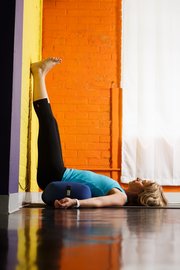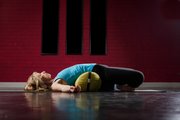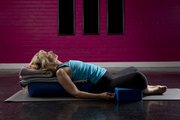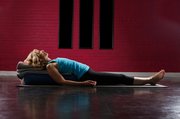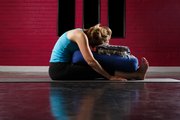Wednesday, October 2, 2013
This is part two in an instructional yoga series, each part focused on yoga positions for different purposes.
For a yoga practice to help with sleep, it is best to have some props, such as a couple of yoga blocks and a yoga bolster; however, firm pillows and firm folded blankets will also work. When your mind is busy and preventing you from sleep, it can be good to let your awareness ride the wave of your breath or focus your mind by silently repeating a mantra--I like the Sanskrit word for nectar, "amrita," pronounced um-ree-TA--or an inspiring word or phrase. As your mind wanders, gently bring your awareness back to your breath or your mantra.
Model: Tamar Sharp, owner of the Fairview Inn, age 55
Viparita Karani
(Inverted Action Pose or Legs Up the Wall)
Have a bolster or two or three folded blankets nearby. Lie on your right side with your butt touching the wall. Roll onto your back and shift your legs up the wall. Press your feet into the wall to lift your hips and guide the bolster under you to support your sacrum--the flat triangular bone above your tailbone. You may have to wiggle a bit to find the sweet spot. Ideally, your sitting bones will be on the wall, but if it is uncomfortable, move further away from the wall.
Close your eyes and hold five to 15 minutes, breathing comfortably.
DO: • Check with your doctor if you have glaucoma, unregulated high blood pressure or are pregnant.
• Relax your face, neck, throat and jaw.
• Support your neck with a small rolled blanket if needed.
• Breathe steadily and easily.
DON'T: • Do this pose while menstruating unless with an experienced teacher.
• Hold your breath.
BENEFITS: • Relieves tired legs and feet.
• Boosts the immune system.
• Relieves lower backache.
• Gently stretches the hamstrings.
• Relieves anxiety, stress and insomnia.
Salamba Setu Bandha in Sukhasana
(Supported Bridge in Easy Pose, or crossed legs)
Coming into the pose: Place a block on the ground. Place a bolster or firm pillow parallel to the block. Sit on the block in a simple cross-legged position and gently lie down over the bolster to rest your shoulders and head on the floor. Keep your neck in a neutral position and turn your palms up to help release your shoulders to the floor.
Close your eyes and hold three to five minutes, breathing comfortably.
DO: • Relax your face, neck, throat and jaw.
• Support your neck with a small rolled blanket if needed.
• Breathe steadily and easily.
DON'T: • Do this pose if it hurts your lower back.
• Hold.
BENEFITS: • Calms the mind.
• Relieves stress and insomnia.
• Balances the thymus and thyroid glands. Tones the abdominal organs and improves digestion.
Supta Baddha Konasana
(Reclining Bound Angle Pose)
Coming into the pose: Place a bolster or firm pillow on the ground with a folded blanket on top. Sit on the ground in front of the bolster, bend both knees out to the side and place the soles of your feet together in a "butterfly" position. Place a block or folded blanket under each knee for support and slowly lie back onto the bolster—which should run the length of your spine—with the folded blanket supporting your head. Let your inner groins soften toward the ground. Relax your arms at a 45-degree angle out to the side with your palms up.
Close your eyes and hold three to five minutes, breathing comfortably.
DO: • Relax your face, neck, throat and jaw.
• Breathe steadily and easily.
DON'T: • Do this pose without an experienced teacher if you have a knee or groin injury.
• Hold your breath.
BENEFITS: • Expands the chest, and opens the hips and groins.
• Helps relieve stress, anxiety and mild depression.
• Calms the mind, soothes the nervous system.
• Stimulates the abdominal organs and improves digestion.
Salamba Savasana
(Supported Corpse Pose or Supported Relaxation)
Coming into the pose: Place a bolster (or firm pillow) to go up the length of your spine. Fold a blanket or use a small pillow to support your head. With your hips on the ground, inhale and lengthen your spine. As you exhale, slowly lie back on the bolster and adjust the support for your neck and head to a comfortable position. Release your arms to the ground at a 45-degree angle from your body and turn your palms up to help release your shoulders.
Close your eyes and hold five to 15 minutes,breathing comfortably.
You may also do this pose in your bed without props and drift off to sleep.
DO: • Relax your hips, legs and feet.
• Relax your shoulders, arms and hands.
• Soften your abdominal muscles.
• Relax your face, neck, throat and jaw.
• Relax your inner ears.
• Soften your eyes, relax your brain away from the edge of your skull.
• Breathe steadily and easily.
DON'T: • Worry.
• Hold your breath.
BENEFITS: • Relaxes the body.
• Relieves stress and insomnia.
• Reduces fatigue.
• Lowers blood pressure.
Salamba Paschimottanasana
(Supported Seated Forward Fold)
Coming into the pose: Sit on the floor with your legs together and straight out in front of you. Align your legs so that your knees and toes point toward the ceiling. If it is uncomfortable or difficult to do with a straight spine, place a folded blanket or two under your sitting bones to elevate your hips. Place a bolster (or firm pillow) on top of your legs and draw it to your abdomen for support. Press your thigh bones down, inhale and lengthen your spine. As you exhale, flex your hips to rest your torso on the bolster. Place a folded blanket under your forehead. Rest your hands on the floor or, if possible, hold your feet with your hands
DO: • Elevate your hips with a blanket to take tension out of the hamstrings.
• Use enough blankets to rest your torso and forehead comfortably.
• Breathe steadily and easily.
DON'T: • Do this pose if you have back issues or injury.
• Hold your breath.
BENEFITS: • Stretches the back, hamstrings and calves.
• Soothes the nervous system and calms the mind.
• Relieves stress and anxiety.
• Therapeutic for insomnia.
